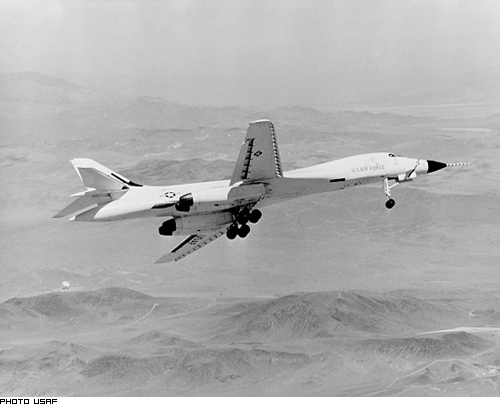B-1A
Summary
| Category | Bombers |
| Origin country | 🇺🇸 United States |
| Manufacturer | Rockwell |
| First flight | 23 December 1974 |
| Year introduced | 1986 |
| Number produced | 104 units |
| Average unit price | $250 million |
Description
The B-1 was first envisioned in the 1960s as a bomber that would combine the Mach 2 speed of the B-58 Hustler with the range and payload of the B-52, ultimately replacing both. After a series of studies, North American Rockwell won the design contest for what emerged as the B-1A. Prototypes of this version could fly Mach 2.2 at high altitude and long distances and at Mach 0.85 at very low altitudes. The program was canceled in 1977 due to its high cost, the introduction of the AGM-86 cruise missile, and early work on the B-2 stealth bomber. The program was restarted in 1981, largely as an interim measure due to delays in the B-2 stealth bomber program. The B-1A design was altered, reducing top speed to Mach 1.25 at high altitude, increasing low-altitude speed to Mach 0.92, extensively improving electronic components, and upgrading the airframe to carry more fuel and weapons. Named the B-1B, deliveries of the new variant began in 1985; the plane formally entered service with Strategic Air Command (SAC) as a nuclear bomber the following year. By 1988, all 100 aircraft had been delivered.
The B-1 has a blended wing body configuration, with variable-sweep wings that can move from 15 degrees to 67.5 degrees. Forward-swept wing settings are used for takeoff, landings, and high-altitude economical cruise, while aft-swept wing settings are employed in high subsonic and supersonic flight. This feature, along with its thrust-to-weight ratio, provides improved takeoff performance, allowing it to operate from shorter runways compared to previous bombers. The aircraft's length can create flexing problems due to air turbulence at low altitudes; to counter this, Rockwell incorporated small triangular fin control surfaces, or vanes, near the nose. The B-1's Structural Mode Control System moves these vanes, and the lower rudder, to counteract the effects of turbulence and smooth out the ride. Unlike the B-1A, the B-1B cannot reach Mach 2+ speeds, but its low-level speed is increased, and it incorporates serpentine air intake ducts and fixed intake ramps to help lower its radar cross-section.
The B-1B possesses considerable conventional and standoff capabilities, featuring three internal bays capable of carrying up to 75,000 pounds (34,000 kg) of ordnance, in addition to six external hardpoints that expand the total payload capacity to 50,000 pounds (23,000 kg). This allows for a diverse array of weapons, including the AGM-154 Joint Standoff Weapon (JSOW), AGM-158C Long Range Anti-Ship Missile (LRASM), and AGM-158 Joint Air to Surface Standoff Missile (JASSM). The aircraft is also slated to integrate the AGM-183 Air-Launched Rapid Response Weapon (ARRW). The aircraft can deploy a variety of bombs, such as Mk-82 air inflatable retarder (AIR) general purpose (GP) bombs, Mk-82 low drag general purpose (LDGP) bombs, Mk-62 Quickstrike sea mines, Mk-84 general-purpose bombs, and Mk-65 naval mines. Cluster munitions like CBU-87/89/CBU-97 and CBU-103/104/105 Wind Corrected Munitions Dispensers (WCMD) can be carried, as well as guided bombs including GBU-31 JDAM GPS guided bombs, GBU-38 JDAM GPS guided bombs, and GBU-54 LaserJDAM.
The B-1B formally entered service with Strategic Air Command (SAC) as a nuclear bomber in 1986. However, with the disestablishment of SAC and its reassignment to the Air Combat Command in 1992, the B-1B's nuclear capabilities were disabled and it was outfitted for conventional bombing. The B-1 was first used in combat during Operation Desert Fox in 1998 and again during the NATO action in Kosovo the following year. The B-1B has also supported U.S. and NATO military forces in Afghanistan and Iraq.
Main Variants:
-
B-1A: The original B-1 design featured variable engine intakes and a top speed of Mach 2.2, with four prototypes built but no production units manufactured.
-
B-1B: This revised design incorporated a reduced radar signature, a top speed of Mach 1.25, and optimization for low-level penetration, with 100 units produced.
-
B-1R: A proposed upgrade from 2004, this variant aimed to enhance existing B-1B aircraft with advanced radars, air-to-air missiles, and new Pratt & Whitney F119 engines, increasing the top speed to Mach 2.2 but shortening the range by 20%.
Technical specifications
| Version: B-1A | |
|---|---|
| Crew | 4 members |
| Operational range | 9,800 km (6,089 mi) |
| Maximum speed | 2124 km/h (1320 mph) |
| Wing area | 594 m² (6393.8 sqft) |
| Wingspan | 41.7 m (136.7 ft) |
| Height | 10.4 m (34.1 ft) |
| Length | 52 m (170.6 ft) |
| Service ceiling | 18,900 m (62,008 ft) |
| Max. takeoff weight | 179,169 kg (395,000 lbs) |
| Powerplant | 4 x turbojets General Electric F101-GE-100 delivering 7700 kgf each |
Current operating countries
All operators
